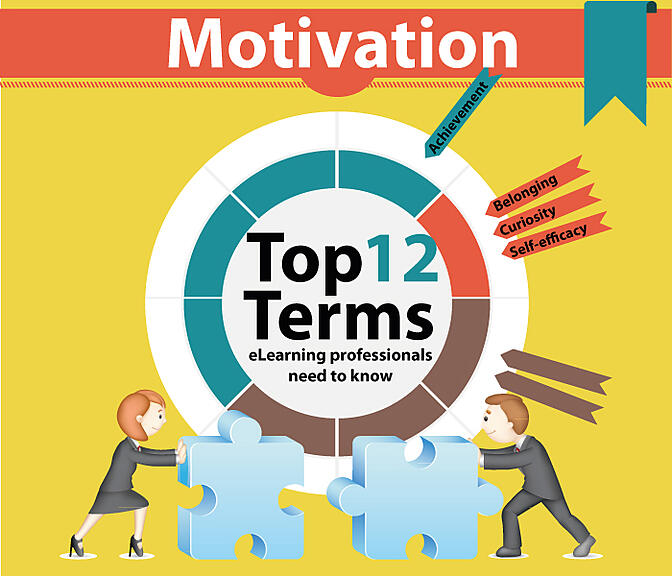Here are some eLearning motivation terms every eLearning course developer should know. By familiarizing yourself with these concepts, you can feel more confident that your eLearning courses will be successful and motivational.
For starters, let’s describe motivation.
"Motivation is the purpose or psychological cause of an action". Or in other words, it’s an incentive or reason for doing something. Without doubt, it's the driving force by which humans achieve their personal and professional goals.

Achievement Motivation:
Can be defined as a learner's desire to achieve goals, receive feedback, perform well and experience a sense of accomplishment. As an eLearning professional, you need to celebrate your learners' accomplishments in visible ways. Recognizing and supporting their efforts will make them feel enough motivated to keep on through difficult tasks. Learners will be motivated to take an eLearning course and retain important knowledge as they know it will help them perform better.
ARCS Model:
The ARCS Model of Motivational Design, the brainchild of John Keller, is based on Tolman’s and Lewin’s expectancy-value theory, which presumes that learners are motivated when there perceive a value in the knowledge presented.
Kelly’s model is made up of four main areas: Attention, Relevance, Confidence and Satisfaction. Attention and Relevance are especially essential for motivating learners, while Confidence and Satisfaction are supplementary components that rely upon the first two areas.
Autonomy:
Autonomy, along with control, stems from self-regulated learning. Autonomous learners enjoy a higher degree of motivation and enjoyment when it comes to learning. They are also tend to be open-minded and adopt a flexible approach in learning.
Attribution Theory:
The theory asserts that motivation varies depending on where an individual attributes the cause of success or failure. If you attribute success to your own actions, then you are likely to get motivated. But if you attribute success to external factors such as luck or talent, then motivation is hard to achieve.
Belonging:
Naturally, people have a strong need for belonging. The state of Belonging means that a student is a valued member of a community. It’s what makes a student feel good and engaged in a learning environment. As an eLearning professional, you have the opportunity to establish a culture of Belonging in your online environment, one that encourages your students' sense of wellbeing, connection, and self-confidence.
Curiosity:
Curiosity is a universal human trait. It is also at the very core of learning. When tapped, curiosity turns an eager student into a motivated learner who seek meaning and coherence through deep reading and thorough investigation of the subject. Curiosity, therefore, is the driver of intellectual achievement.
Expectancy or Fulfillment:
The feeling of expectancy or fulfillment comes after one has achieved a learning milestone or goal. Every achievement, big or small, leads to further motivation.
Goal Setting:
Concrete and reasonable goals increase motivation. Without them, an individual can easily escape or stop what he or she has started.
Goal-setting, as a crucial aspect of self-regulation, can increase an adult student’s eLearning success. Having completed goals or at least progressing partially, students are able to perceive themselves positively and thus motivate them to increase their knowledge or skill levels. Make sure learners know what to expect or what goals to target, no matter how big or small.
Intrinsic and Extrinsic Motivation:
Intrinsic motivation, on the one hand, happens when a person feels motivated by doing the task itself. Extrinsic motivation, on the other hand, happens when an individual feels motivated by the result, which can be a reward, position or fame. Students who enjoy a task of its own sake, for instance, are intrinsically motivated. Those who study solely for the purpose of getting higher grades are extrinsically motivated.
According to researchers, intrinsic motivation leads to competence and enjoyment; while greater extrinsic motivation coupled with independence and engagement encourages better performance; fewer dropouts and better psychological health.
Self-Efficacy:
Self-efficacy is the perception of how effective one is in managing difficulties. If a student thinks that he or she will fail no matter big the effort, then there can be no motivation. But if a student thinks that things are doable and goals are achievable, then motivation naturally arises.
Self-Regulation:
The concept involves learners being proactive and in control of their learning goals and strategies. Self-regulated learner are naturally motivated.
Self-regulation has a lot to do with a learner’s self-perfection. That is why evaluating an individual’s believe in his or her ability to regulate learning may be equally important as assessing his or her level of self-regulation.
Social Context:
This refers to the learner’s milieu or social environment. It can either be competitive or cooperative. According to research, a cooperative context can increase motivation than a competitive context. When others support or encourage what an individual is doing, expect a significant impact on his or her motivation.
By following the ABC's of motivation, you can succeed on the road to effective eLearning development! Guranteed!









